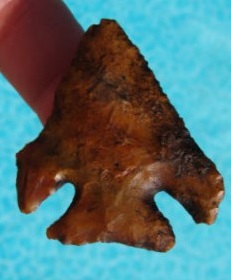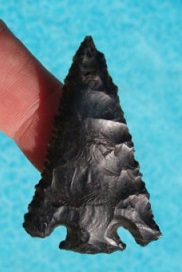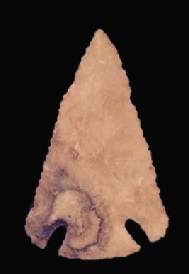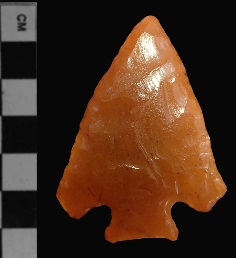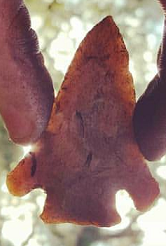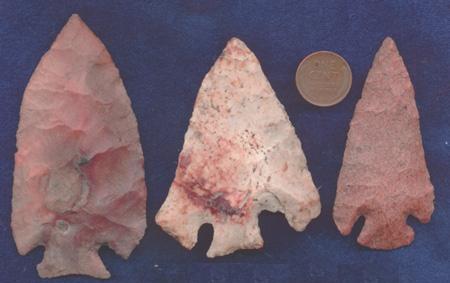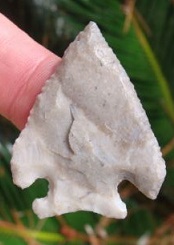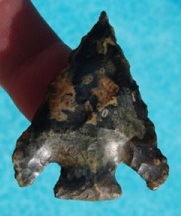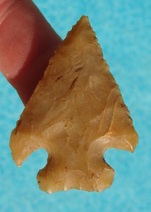Outline is Representative of Size and Shape:
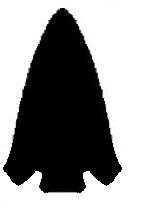
Name Details:
Identified By: Ripley P. Bullen
Named For: Clay County Florida
Date Identified: 1968
Type Site:
Identified By: Ripley P. Bullen
Named For: Clay County Florida
Date Identified: 1968
Type Site:
Point Validity:
Valid type
Bullen was a distinguished anthropologist and Curator Emeritus of the Florida Museum of Natural History. He was dedicated to identifying and typing projectile points from Florida. This point was named in a professional publication and is professionally a widely recognized type. This is a valid type.
Bullen was a distinguished anthropologist and Curator Emeritus of the Florida Museum of Natural History. He was dedicated to identifying and typing projectile points from Florida. This point was named in a professional publication and is professionally a widely recognized type. This is a valid type.
Clay Squared Barb
Cluster: Description of Physical Characteristics and Flaking Pattern:
This is a broad medium to large(1.5 to 4 inches) triangular basal notch point with an elliptical cross section towards the tip becoming more flattened towards the base. The blade varies from excurvate to recurvate, curving in at the tip and flaring out at the shoulders. The shoulders are barbed with angular or squared terminations of the barbs, but asymmetrical examples may have one squared termination and one rounded termination. The stem is most commonly expanding, but may range to almost straight. The base varies from slightly convex to slightly concave. Basal thinning is commonly seen. This point has a random flaking pattern. 40% of all examples are asymmetrical (Bullen, 1975).
Size Measurements:
Total Length - 35 to 110 mm (average 53 to 63 mm ), Stem Length - 6 to 14 mm, Blade Width - 25 to 50 mm (average 33 to 38 mm), Neck Width - 8 to 23 mm (average 13 to 16 mm), Stem Width - 10 to 28 mm (average 15 to 23 mm), Thickness - 5 to 9 mm.
Total Length - 35 to 110 mm (average 53 to 63 mm ), Stem Length - 6 to 14 mm, Blade Width - 25 to 50 mm (average 33 to 38 mm), Neck Width - 8 to 23 mm (average 13 to 16 mm), Stem Width - 10 to 28 mm (average 15 to 23 mm), Thickness - 5 to 9 mm.
Commonly Utilized Material:
Additional Comments:
It has been suggested that the Clay point may be a variant of the LaFayette point. They are similar, except where the Clay point has angular or squared barb terminations, the LaFayette point has pointed or rounded barb terminations (Granger and Granger, 2013). Farr (2006) included both types into a single type referring to these points as Clay/Lafayette.
Whately (2002) notes that "George Price (personal communication 2001) makes the interesting observations that Clay points he has examined from Turner County, Georgia are never patinated, about 75% are made using curved flakes shaped by careless pressure flaking, and these points are never associated with ceramics." However, Farr (2006) feels that these point are associated with Orange Period ceramics.
It has been suggested that the Clay point may be a variant of the LaFayette point. They are similar, except where the Clay point has angular or squared barb terminations, the LaFayette point has pointed or rounded barb terminations (Granger and Granger, 2013). Farr (2006) included both types into a single type referring to these points as Clay/Lafayette.
Whately (2002) notes that "George Price (personal communication 2001) makes the interesting observations that Clay points he has examined from Turner County, Georgia are never patinated, about 75% are made using curved flakes shaped by careless pressure flaking, and these points are never associated with ceramics." However, Farr (2006) feels that these point are associated with Orange Period ceramics.
Distribution: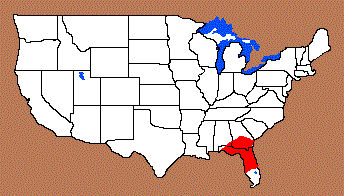
Distribution Comments:
This point is primarily found from central Florida and into Southern Georgia and southeastern Alabama.
This point is primarily found from central Florida and into Southern Georgia and southeastern Alabama.
Age / Periods:
Date: 4,000 - 3,000 B.P.
Cultural Period:Late Archaic
Glacial Period: Neoglacial
Culture:
Date: 4,000 - 3,000 B.P.
Cultural Period:Late Archaic
Glacial Period: Neoglacial
Culture:
Age Details:
Other points in this cluster / Related / Associated Points:
Lafayette
Lafayette

